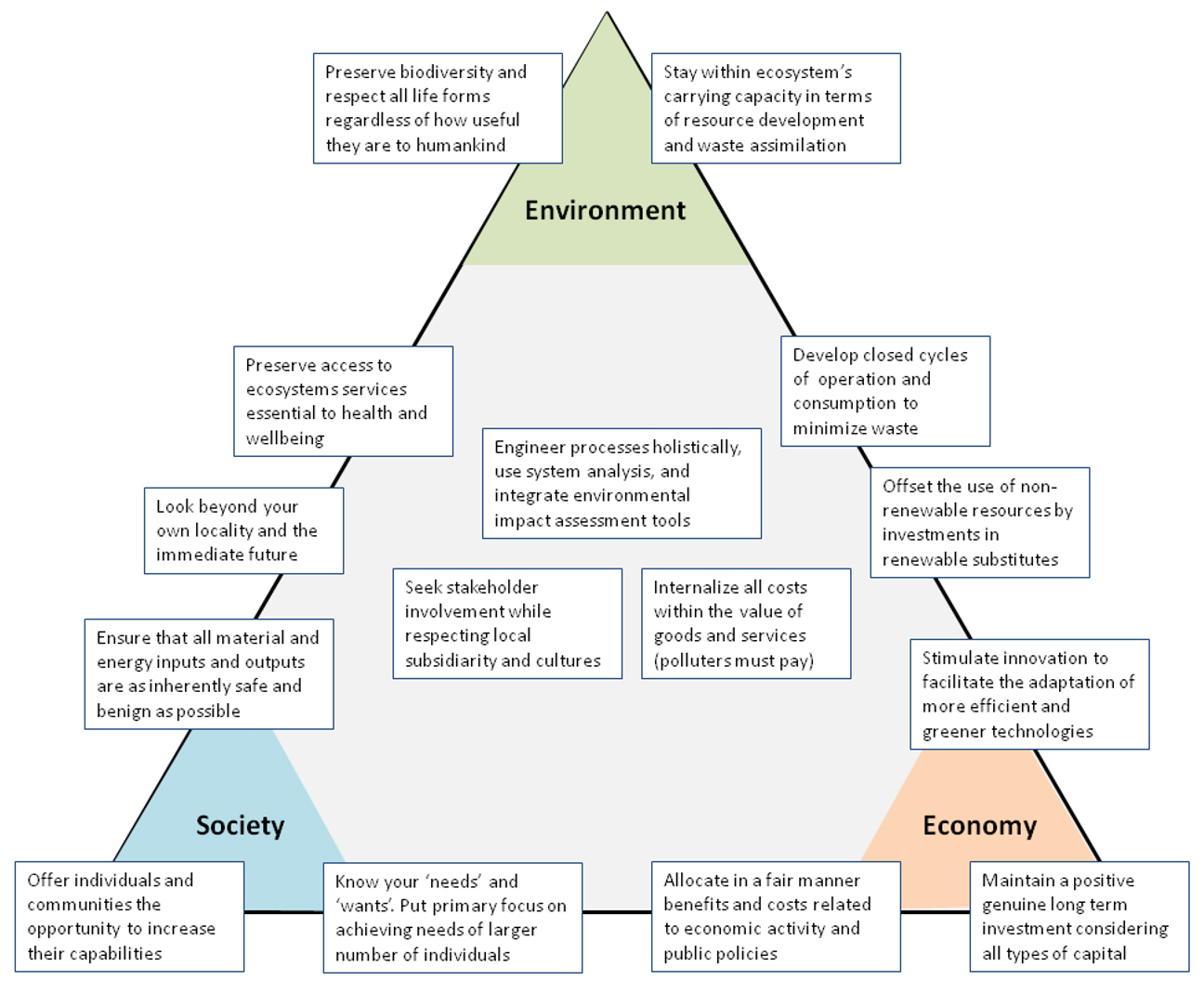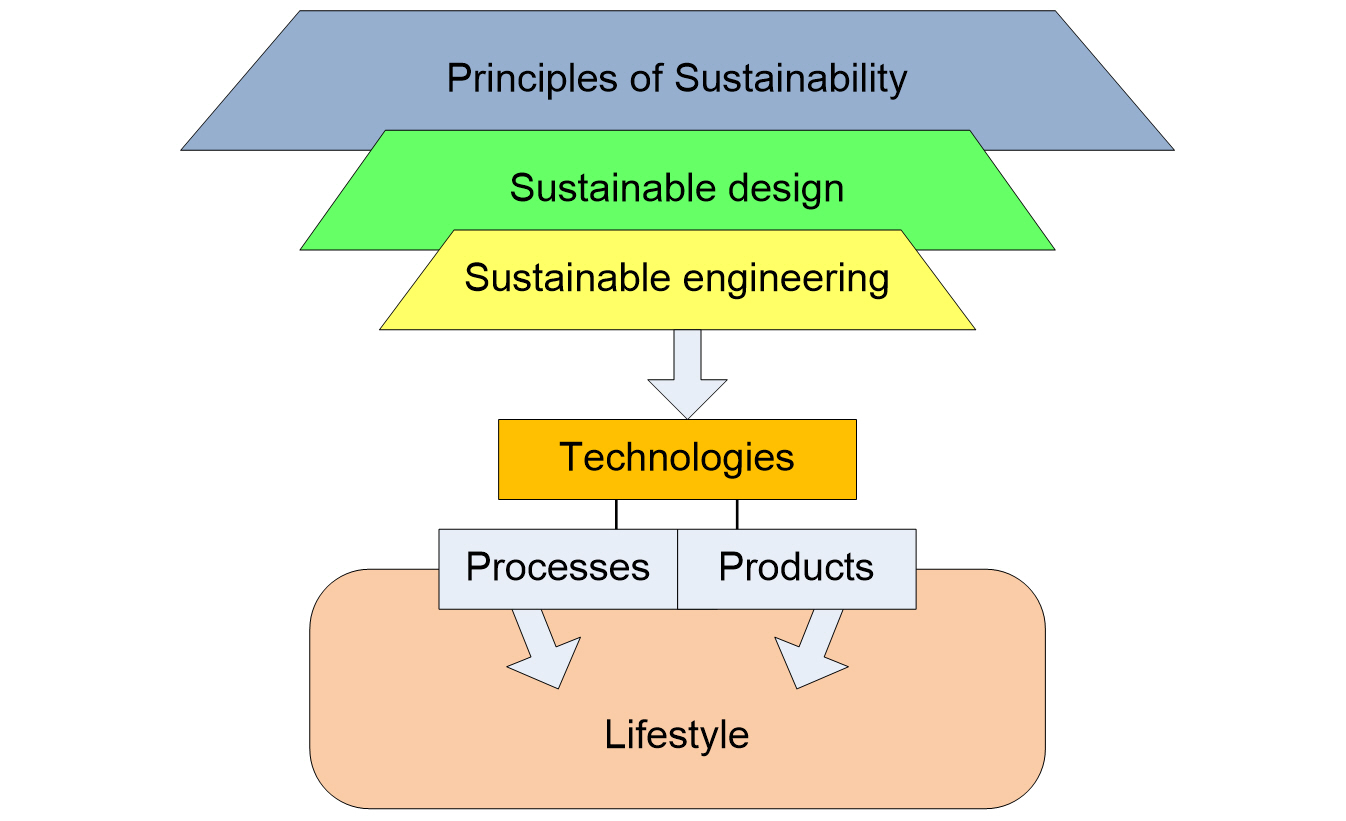1.4 Principles of Sustainable Engineering
"Engineering in context, engineering with a conscience, engineering for a finite planet and the indefinite future"
-Benoit Cushman-Roisin
Sustainable engineering should be based on principles that support sustainable development, as defined in the upper sections of this lesson. Engineering forms an interface between the design (i.e., the idea how to provide a sustainable solution to a technical problem) and implementation and production. In case of technology development, engineering phase is linked to almost every level of technology readiness spectrum. Sustainable engineering principles should be contemplated and applied early to ensure that technology development and scale-up follow the environmentally benign route. It will be hard to turn back to redo and redesign things from later stages! In that sense, the sustainable engineering principles should be taken into account in decision making for both research and industrial projects, as well as in policy making and decisions regarding funding of technological research.
There have been multiple attempts by academic and industrial institutions to formulate sustainable engineering principles. All of them fall within the triangle with Environmental, Social, and Economic values as cornerstones. The overarching goal is to generate a balanced solution to any engineering problem. If an engineering project benefits one of these three aspects but ignores the others, we have a lopsided system which creates tension, instability, and new problems in the long run.
Here are some of the aspects that differentiate the traditional and sustainable approaches in engineering:
| Traditional Engineering | Sustainable Engineering |
|---|---|
| Considers the object or process | Considers the whole system in which the object or process will be used |
| Focuses on technical issues | Considers both technical and non-technical issues synergistically |
| Solves the immediate problem | Strives to solve the problem for infinite future (forever?) |
| Considers the local context | Considers the global context |
| Assumes others will deal with political, ethical, and societal issues | Acknowledges the need to interact the experts in other disciplines related to the problem |
The diagram in Figure 1.3. presents a consolidated framework for sustainable engineering principles, which are in part adopted from the work of Gagnon and co-authors "Sustainable development in engineering: a review of principles and definition of a conceptual framework" (2008) and from the green engineering principles established by Sundestin Conference (2003).

Figure 1.3 text description
Various principles of sustainable engineering are placed on the perimeter of the triangle. On the triangle's bottom edge are the Society pole (left) and the Economy pole (right). From left to right, the four principles shown are as follows:
- Offer individuals and communities the opportunity to increase their capabilities.
- Know your "needs" and "wants." Put primary focus on achieving needs of larger number of individuals.
- Allocate in a fair manner benefits and costs related to economic activity and public policies.
- Maintain a positive genuine long term investment considering all types of capital.
On the triangle's left edge are the Society pole (bottom) and the Environment pole (top). From bottom to top, the four principles shown are as follows:
- Ensure that all material and energy inputs and outputs are as inherently safe and benign as possible.
- Look beyond your own locality and the immediate future.
- Preserve access to exosystems services essential to health and wellbeing.
- Preserve biodiversity and respect all life forms, regardless of how useful they are to humankind.
On the triangle's right edge are the Environment pole (top) and the Economy pole (bottom). From top to bottom, the four principles shown are as follows:
- Stay within ecosystem's carrying capacity in terms of resource development and waste assimilation.
- Develop closed cycles of operation and consumption to minimize waste.
- Offset the use of non-renewable resources by investments in renewable substitutes.
- Stimulate innovation to facilitate the adaption of more efficient and greener technologies.
The principles shown at the center of the triangle are as follows:
- Engineering processes holistically, use system analysis, and integrate environmental impact assessment tools.
- Seek stakeholder involvement while respecting local subsidiarity and cultures.
- Internalize all costs within the value of goods and services (polluters must pay).
Figure 1.3 lists the various principles of sustainable engineering versus environmental, social, and economic poles. Some of these principles clearly gravitate towards one of the corners of this triangle and thus address particularly societal, environmental, or economic concern. But some others, which are placed along the sides of the triangle, have connections to two of the poles of the diagram and address both societal and economic, or both economic and environmental concerns in some proportion. Those principles placed in the center of the diagram combine all three aspects of sustainability to a certain degree and hence their implementation would benefit all societal, environmental, and economic stakeholders. We should not consider this collection of principles set in stone. Many sources and organizations build on the existing documents and provide their own visions. I invite you to reflect on this diagram and provide your comments for making it more complete and more concrete for our future consideration.
These principles can be viewed as guidelines for a specific engineering project. We are going to look at a specific example where the engineering solution was able to address the need and benefit sustainability, not sacrificing one for the other.
Jubilee River Case Study
Reading assignment
Venables, R., Civil Engineering - Jubilee River, in Engineering for Sustainable Development: Guiding Principles, Royal Academy of Engineering, Dodds, R., and Venables, R., Eds., 2005. pp. 11-14.
Note: I ask you to read the case study on pages 12-14 only! After that, please answer the self-check questions below.
This example presents a success story about how sustainable engineering has been applied to address a critical community need. The need is always placed in the center of an engineering project and directs design efforts. In this case, the need was a flood prevention system. While the traditional approach of creating the concrete trapezoidal channel would address the need perfectly and cost-effectively, it would have environmental and social trade-offs. For example, construction would destroy or disturb natural vegetation and wildlife, cause high soil erosion, create a large amount of construction waste, and have a negative aesthetic impact.
The alternative approach was to convert these problematic trade-offs into benefits. That required some additional investment and a wider range of collaboration among civil engineers, ecologists, and landscape architects. The result was creation of a permanent, landscaped, ecologically compatible relief channel, with amenities and environmental features of a natural river (Figure 1.5), which eventually became an asset to the community and increased rather than decreased the quality of life.

To summarize the information in this reading, please provide answers to the following questions:
Self-check questions:
1. What was the key to making the Jubilee River channel stable under high flow conditions?
Click for answer.
Established vegetation (e.g. shrubs, trees) was necessary to fix the banks and to avoid excessive erosion.
2. What sustainable construction measures were implemented in the project?
Click for answer.
First, the routes for removal of excavation waste were established prior to the construction; second, the excavated gravel and soil were used for landscaping along the river banks.
3. What technology was used to plan and control excavation works and to prevent over-digging?
Click for answer.
Geographic positioning system (GPS) was used for careful planning and for optimizing the position and depth of excavation.
4. What were the key benefits of the Jubilee River project?
Click for answer.
(a) flood prevention (main need);
(b) better quality of life;
(c) maintained wildlife environment;
(d) protected land and soils;
(e) wise use of natural resources.
The goal of an engineering project can be to create a system, a device, a process, or any other outcome that would provide a certain service or benefit to society. One of the important outcomes of an engineering project is the creation of technology.
Role of Technology
Role of technology can be actually viewed as the interface that provides connection of an idea realized through design and engineering effort with practical and consumable outcomes, such as products or services. The latter would affect and shape societal lifestyle over time. Figure 1.4 presents a hierarchical view of these connections in the sustainability context.

Figure 1.5 shows how the most general sustainability principles are narrowed down to specific material outcomes for the society. The principles of sustainability guide the sustainable design, the process of thinking. This stage determines how things are supposed to be made and how they will function over their whole lifecycle. Further down the funnel, the sustainable engineering stage deals with technical implementation of ideas. Sometimes it is not an easy process, and some aspects of design may be changed or compromised. When eventually the design and engineering routes practically converge, we may have a technology created. Technology provides processes and products. Only then the benefits of new ideas and new engineering developments become available to society. Here we can identify the role of technology as some sort of portal through which the established principles of sustainable design and engineering may affect people’s lifestyle. Because of people's strong dependence on multiple technologies, those become the factors that can facilitate change in society and can even become tools of manipulation and initiation of global trends.
Technology serves as a portal through which the established principles of sustainable design and engineering can reach the society and affect societal lifestyle.
This way of thinking emphasizes the importance of technologies in the whole hierarchy of causes and factors that regulate the sustainable development.
Supplemental Reading
Engineering for Sustainable Development: Guiding Principles, Royal Academy of Engineering, Dodds, R., and Venables, R., Eds., 2005.
This additional reading on this section provides you with some examples of sustainable engineering projects. These demonstrate the wide application of sustainable engineering thinking in such spheres as water management, chemical industry, and electronics.
Gagnon, B., Leduc, R., and Savard, L., Sustainable development in engineering: a review of principles and definition of a conceptual framework. Cahier de recherche / Working Paper 08-18, 2008.
